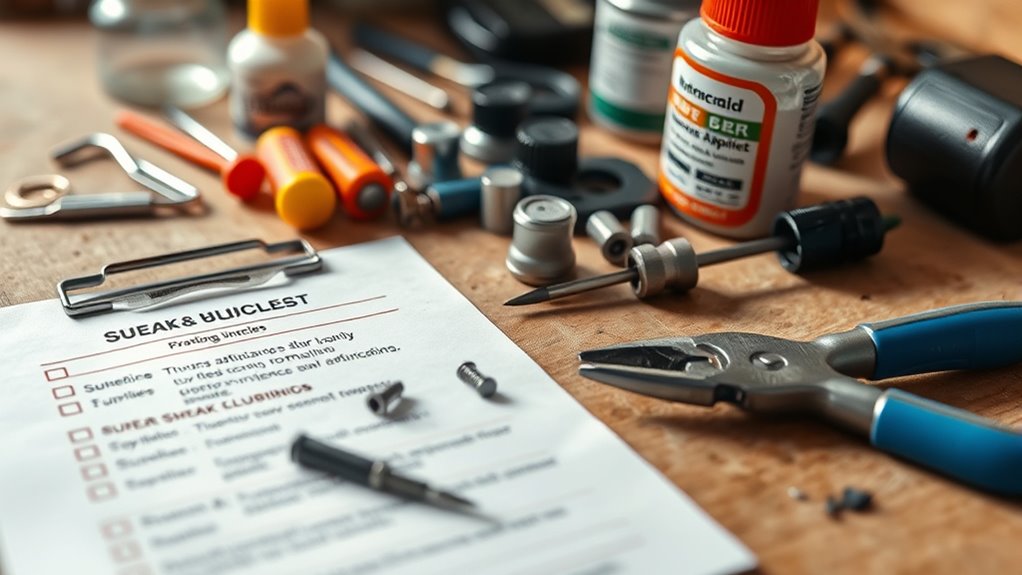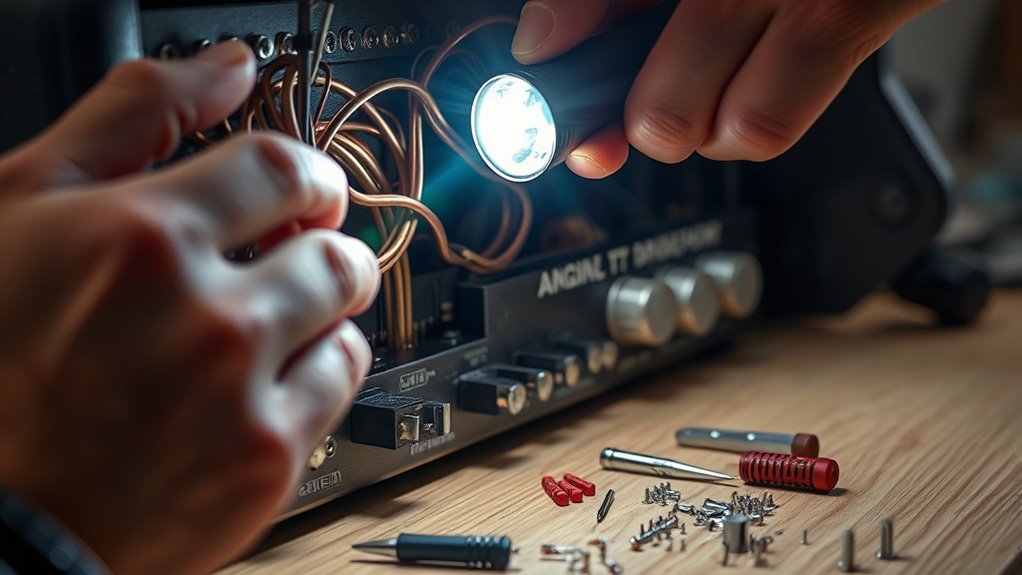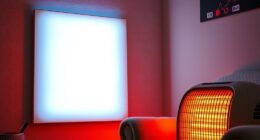To fix squeaks and buzzes, start by inspecting hinges and panels for looseness, dirt, or rust. Apply lubricant like WD-40 to hinges and tighten any loose screws or clips securing panels. Use a small tool to pinpoint the exact noise source, then add felt pads or rubber spacers to dampen vibrations. Regular maintenance of hinges and fasteners helps prevent future issues. Keep exploring for more tips to keep your space quiet and smooth.
Key Takeaways
- Inspect hinges and fasteners for dirt, rust, or looseness; clean and tighten as needed.
- Apply suitable lubricants like WD-40 or silicone spray to squeaky hinges for smooth operation.
- Identify the source of buzzes or rattles by tapping or pressing areas to target repairs accurately.
- Use felt pads, rubber spacers, or adhesive strips to dampen vibrations and prevent future noises.
- Regularly maintain hinges and fasteners to ensure long-term silence and prevent recurring squeaks or buzzes.
Simple Steps to Eliminate Squeaks and Buzzes

Have you ever been annoyed by squeaks and buzzes in your home or vehicle? These noises can be distracting and even frustrating, but the good news is that many of them are simple to fix if you know where to look. Starting with door hinges is often the easiest step. Over time, hinges can become loose or develop rust, leading to squeaking sounds every time you open or close a door. To fix this, first, open the door and inspect the hinges closely. If they look dirty or rusty, clean them with a wire brush or a damp cloth. Once they’re dry, apply a few drops of lubricant like WD-40 or a silicone spray directly onto the hinges. Open and close the door a few times to work the lubricant in. This quick fix usually silences the squeak and prevents it from returning soon. Additionally, choosing a lubricant with high-quality formulation can provide longer-lasting results.
Loose panels are another common source of noise, especially in furniture, cabinets, or vehicle interiors. When panels are not tightly secured, they can rattle or buzz, especially when you’re moving or bumping into them. To address this, check all screws, bolts, or clips holding the panels in place. If any are loose, tighten them with the appropriate screwdriver or wrench. Sometimes, the screws are stripped or worn out, so replacing them with new ones can provide a tighter fit. If the panels still rattle after tightening, consider adding some adhesive felt pads or rubber spacers between the panel and its frame. These act as buffers, absorbing vibrations and eliminating the buzz. For panels that keep coming loose, you might also consider using stronger fasteners or replacing worn clips altogether.
Another simple tip for fixing squeaks and buzzes is to identify the precise location of the noise. Sometimes, a noise might seem to come from one area but is actually caused by something nearby. Use your hand or a small tool to gently press or tap different areas while listening carefully, which helps you pinpoint the exact source. Once you know where the noise originates, it becomes easier to apply targeted fixes like lubricating hinges, tightening screws, or adding padding.
Frequently Asked Questions
Can Squeaks and Buzzes Indicate Underlying Mechanical Issues?
Yes, squeaks and buzzes can indicate underlying causes of mechanical issues. These common signs often point to problems like loose parts, worn belts, or misaligned components. When you hear squeaks or buzzes, it’s a signal to inspect your equipment closely. Ignoring these sounds might lead to more serious damage or breakdowns. Addressing them early helps maintain proper function and prevents costly repairs down the line.
How Often Should I Perform Maintenance to Prevent Squeaks?
You should perform maintenance regularly to prevent squeaks by following a consistent lubrication schedule and conducting component inspections. Ideally, you’ll want to lubricate moving parts every few months, depending on usage, and check for any signs of wear or loose components. Staying proactive with these tasks helps avoid squeaks and keeps everything running smoothly. Regular maintenance not only prevents issues but also extends the lifespan of your equipment.
Are There Specific Tools Recommended for Fixing Squeaks and Buzzes?
Imagine you’re troubleshooting a squeaky door; you’ll need a good lubricant, like silicone spray, to reduce friction effectively. For fixing squeaks and buzzes, you should use diagnostic tools like a stethoscope or a sound level meter to pinpoint the source. These tools help identify whether lubrication or tightening is needed, ensuring you select the right lubricant and approach for each issue, making your repairs more efficient.
Can Environmental Factors Worsen Squeaks and Buzzes Over Time?
Yes, environmental impact and seasonal changes can worsen squeaks and buzzes over time. As temperature and humidity fluctuate, materials like wood and metal expand or contract, causing increased friction and noise. You might notice more squeaks during humid summers or cold winters. These environmental factors gradually loosen joints or create new gaps, making squeaks and buzzes more persistent. Staying aware of seasonal changes helps you anticipate and address noise issues early.
Is It Safe to Attempt Repairs Without Professional Help?
Did you know that over 60% of DIY repairs lead to more issues? It’s generally safe to try fixing squeaks and buzzes if you follow proper DIY safety precautions, like wearing gloves and using the right tools. However, for complex problems or if you’re unsure, it’s wise to seek professional consultation to avoid damage or injury. When in doubt, consulting a professional ensures your repair is safe and effective.
Conclusion
By following this checklist, you’ll banish squeaks and buzzes faster than a superhero saves the day. Say goodbye to annoying noises that can drive anyone mad and welcome a world of peace and quiet with the power of your newfound skills. With patience and a keen ear, you’ll transform your space into a sanctuary so serene, even the most stubborn squeaks will tremble in defeat. Prepare to conquer noise like the ultimate champion of tranquility!









